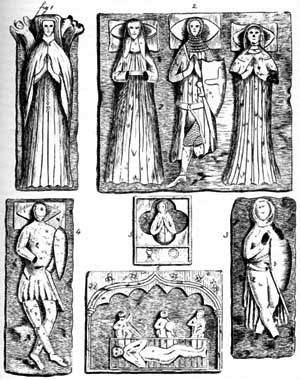
Laxton (and Tuxford) church monuments sketched by John Throsby in the 1790s.
Indications remain to shew that their tomb on the north side of this church was originally built as an altar with a high gabled canopy after the manner then prevailing (see Archbishop Greenfield's tomb in the east side of the north transept at York 1306-1315), but it has been cut down and despoiled in order to contain effigies which were never intended for it; indeed none of the effigies now in the church appertain to the Lexingtons, although Throsby's illustration shews the Lexington arms carved on the breast of the Knight on the north side (Argent, a cross flory Azure) whereas it is clearly a rampant lion for Everingham as you may see. It is only fair to say that during Throsby's visit the tombs were so covered with dirt and dust that he found it difficult to sketch them. (Note :—The arms of Lexington are nowhere to be seen in the church to-day).
The arms of their posterity, the Bekerings and the Longvilliers, are carved on the dripstone terminations of the east window of the north aisle (modern) the Everingham lion is carved on the Knight's shield borne by one of the effigies, and the Roos "water bougets" are carved on the central beam of the nave roof. These are all the remains of the wealth of heraldry which once adorned the church.
Much confusion has arisen concerning the effigies, because they have been mutilated and misplaced until they are almost beyond recognition; moreover the chapels appear to have been used for day schools in more recent years—a course always attended with dire results to church fittings and monuments:
"Wonder not mortal, at thy quick decay; See ! men of marble piece-meal pass away. When whose the image we no longer read, But monuments themselves memorials need."
Crabbe.
When this Society last visited this church in 1902 (September 4th) the late William Stevenson gave an exhaustive description of the monuments as you will find in Transactions, Vol. VI.
I might briefly summarize his account thus:— The monuments on the South side, taken in rotation and not chronologically are:—
(1) |
Robert Everingham, died 1287, Mansfield stone. |
(5) |
Baron Adam de Averingham, died 1370, Mansfield stone. |
(6) |
Baron Reginald de Everingham, died 1399, Alabaster. |
Thoroton says the Everingham lion was painted on this effigy.
North side.
(2) |
Adam de Everingham, born 1280, died 1336, Aubigny marble, (son of No. 1, with lion carved on shield. |
(3) |
First wife of ditto, died without issue, Aubigny marble. |
(4) |
Second wife, Margaret, "but the image of that wife is cut in wood" — the only example we have left in the county. |
Margaret's surname is not given. Was it Rouclyffe or Radcliffe I wonder? One other effigy in the county is known to have been "cut in oak" viz.:—Stephen de Radcliffe, who died in the reign of Henry III and was buried under an arch in the south wall of Radcliffe-on-Trent Church "under his image cut in oak." After the battle of Waterloo this wooden effigy was taken from the church at Radcliffe, dressed up as Napoleon Buonaparte, carried in procession through the streets, and afterwards publicly burned.
The Sanctuary is chiefly of 14th century date and contains several features of great interest. The east window is modern, but the tall two-light windows in the flank-walls to north and south of it are unique examples of Decorated work. On the north wall there is the remnant of an Easter Sepulchre. If our surmise is correct that the York school of craftsmen carried out the work at this end of the church, then an Easter Sepulchre is what we should expect to find there: but the earlier enthusiasm of the school seems to have cooled down somewhat by this time, for there is a complete absence of sculpture and very little comparison with their vigorous work at Hawton and elsewhere.
Opposite to the sepulchre is a "low-side" window. This is perhaps the only "low side" window in this district to command a view of the Altar and the Easter Sepulchre. The unusual position of this aperture has called forth much speculation. When we view it externally and realize that the Sanctuary extends only for a short distance beyond the aisles, the position of this opening is seen to be quite normal, for it is the only bit of external walling at the side of the chancel available for the purpose. The aperture is now glazed, but originally it was fitted with a wooden shutter. This shutter would be opened at supreme moments in the service of the Mass in order that a handbell might be rung in accordance with the Injunction of A.D. 1280.
"In the elevation of the Body of Christ let the bells be rung on one side at least, that the people who cannot be daily at Mass wherever they be, whether at home or in the fields, may kneel."
John Packham Archbhp: Canterbury.
